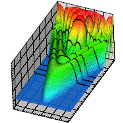Department of Physics and Astronomy: Publications and Other Research

Anthony F. Starace Publications
Document Type
Article
Date of this Version
April 1999
Abstract
We consider the scattering of 50 eV x-rays by hydrogen atoms in the presence of a bichromatic, linearly polarized laser field with frequencies ω and rω, where r = 2, 3, ω = 1.17 eV, and with relative phase &#; between the bichromatic laser field components. Numerical results for the differential cross-section (DCS) as a function of the number n, where nω is the energy exchanged with the laser field, are presented. For either a monochromatic laser field or a bichromatic laser field with the frequencies ω and 3ω, the integer n can only be even, while for a bichromatic laser field with the frequencies ω and 2ω, the integer n can have any value. For small values of |n| we find pronounced maxima in the DCS. For larger |n| we find plateaus which are different for negative and positive values of n. For lower values of the laser field intensity the plateau for negative values of n is much more extended and greater in magnitude than that for positive values of n. The height of either plateau is also higher for the bichromatic laser field than for either monochromatic field. In the (ω, 2ω) case we find the symmetry DCS (φ + π) =DCS (φ). We show that the relative phase φ influences the DCS so that phase control of the x-ray–atom scattering process is possible. For some values of φ the energy of the outgoing x-ray photons can be increased. Finally, a quasi-classical explanation of the results is presented.


Comments
Published in Journal of Physics B: Atomic, Molecular and Optical Physics 32:8 (April 28, 1999), pp. 1831– 1843. Copyright © 1999 IOP Publishing Ltd. Used by permission. http://www.iop.org/EJ/journal/JPhysB